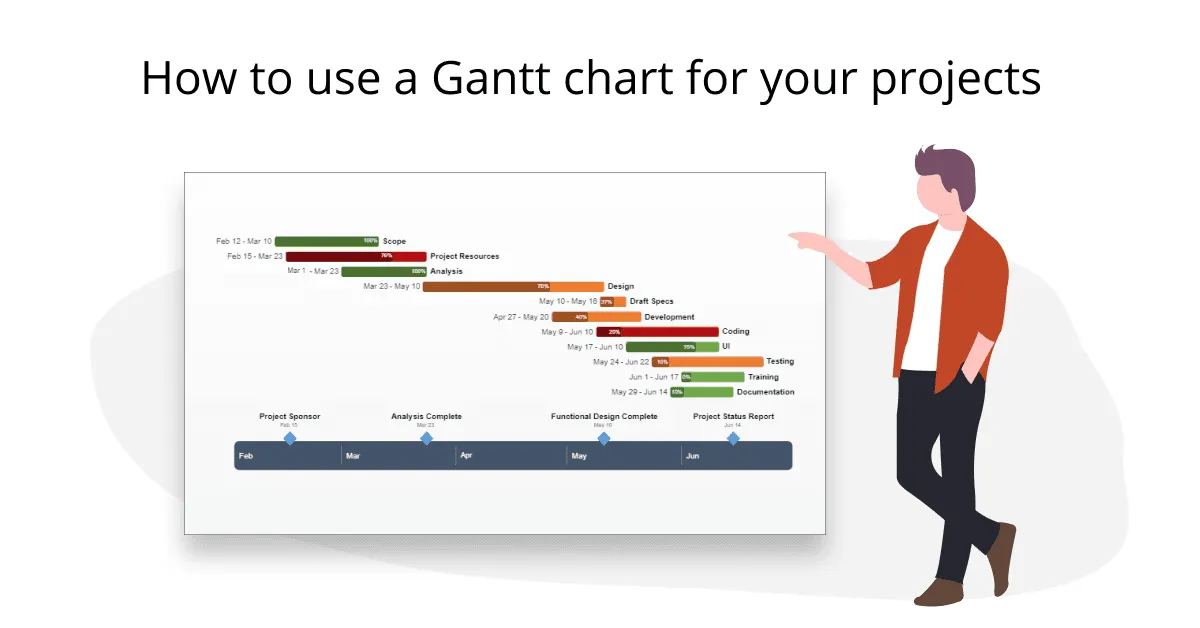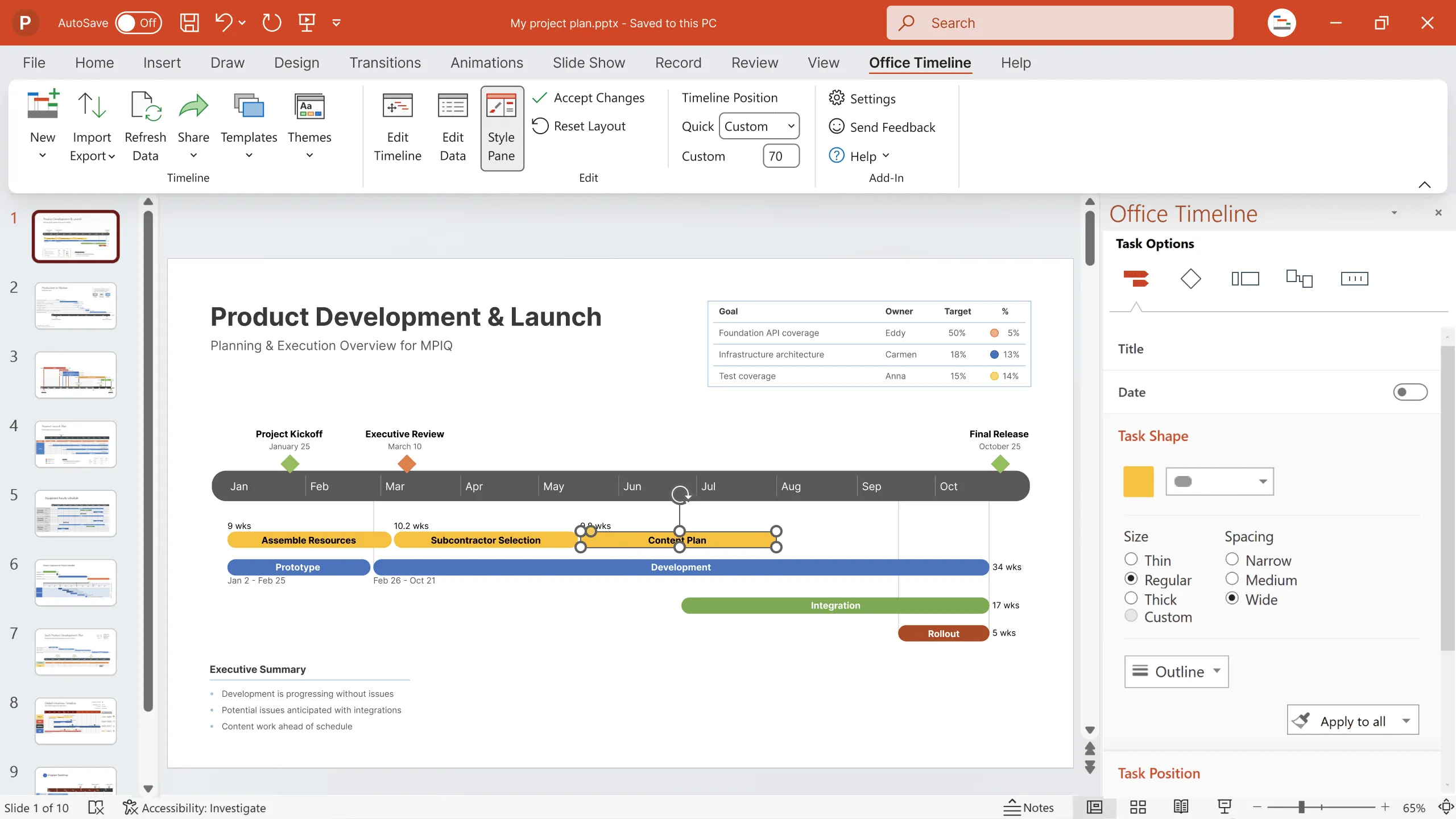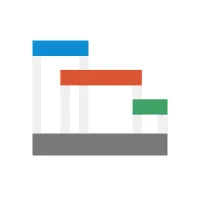Gantt chart 101- Part 1: What are Gantt charts used for?
Learn how you can use a Gantt chart to plan, schedule, and manage your projects. Start customizing our free Gantt chart templates with the Office Timeline tool.

Just started using Gantt charts and you’re still unsure how they work and what’s the best way to use them? You’re in the right place.
In this article, we’ve gathered everything you need to know to get started with Gantt charts and manage your projects successfully. That includes all the basics, from what are Gantt charts to what are the benefits of using Gantt charts, and 5 common scenarios where using a Gantt chart is highly recommended.
What is a Gantt chart?
A Gantt chart is a bar chart commonly used in project management to plan and schedule tasks and track progress. It has a vertical axis where the project tasks are represented in the form of bars and a horizontal axis with their start date, duration, and end date.
The main purpose of a Gantt chart is to simplify complex information and transform it into step-by-step project visuals that are easy to understand for all team members and key stakeholders.
There are many essential details you can view at a glance when using a Gantt chart for your projects, including:
- The project schedule from start to finish
- When each task starts and when it’s supposed to be finished
- When the project starts and when it’s scheduled to be delivered
- The dependencies and overlaps between tasks
- Who is responsible for each task
- Crucial milestones and deadlines for each phase of the project
- The critical path of the project
- The project’s overall progress
A brief history of Gantt charts
We’ve come a long way since the first handwritten Gantt charts. Imagine having to redraw the chart each time a change occurs in the schedule. Not exactly what a manager would like to spend his entire day doing.
Fortunately, these days, modern Gantt chart software allows you to define dependencies, highlight the critical path, monitor progress in real time, and update your chart with just a few clicks. Not to mention, the charts are an absolute pleasure to look at.
But let’s take a quick look at how it all started, shall we?
In the 1890s, Polish engineer Karol Adamiecki created the harmonogram, the first known project chart of this type. However, his authorship received little recognition in the English-speaking world as his findings were only published in Polish and Russian.
Almost 15 years later, Henry Gantt, an American engineer and management consultant, came with his version of Adamiecki’s chart to help manufacturing supervisors visualize their work schedule and progress.
Ultimately, Gantt’s work became widely known in western countries and, long story short, the chart was named after him.
What are the main benefits of using a Gantt chart?
Gantt charts are a useful project management tool if you want to:
- Break complex projects down into achievable tasks and set accurate deadlines and milestones
- Estimate the time and resources required for each task
- Identify overlapping activities and task dependencies
- Visualize your project plan and get a big-picture overview of what tasks need to be done, when, and in what order
- Highlight the critical path and immediately spot any issues that might delay the project delivery
- Monitor progress and present updates to key stakeholders in a visually appealing & easy to comprehend format
- Enhance team communication and accountability
- Organize and track multiple projects at the same time
And now comes the best part: you don’t have to make your charts from scratch anymore. No more endless hours spent trying to get the design right in Excel or struggling to get the hang of Microsoft Project.
Save time and create beautiful project graphics directly in PowerPoint with pre-designed Gantt chart templates. Pick your favorite, customize it and get ready to present.
How to use a Gantt chart for your projects
Apart from being a great way to visualize and communicate the project schedule, there are many other reasons teams from various industries such as marketing, software development, event planning, manufacturing, healthcare, and construction choose to use Gantt charts.
We’ve put together a short list of the most common use cases below. To make it easier for you, we’ve also added the best Gantt chart template for each situation.
1. Communicating project status updates to stakeholders
Apart from managing all the aspects of a project and monitoring progress, a project manager also needs to prepare regular status reports. These reports are used to communicate how things are going to clients and executives.
Having a clear picture of where a project stands can help managers identify potential bottlenecks and take corrective action where needed to get back on the right track. That’s why you must keep your status reports easy to follow and engaging.
The best way to present how the project progresses against the original plan is by creating a Gantt chart. You can use this project status report template to provide your audience with a simple visual representation of progress across different tasks and stages.
2. Creating a software development roadmap
If you’re managing a software development project, one of your biggest challenges is to keep the team, clients, and other relevant stakeholders on the same page at all times.
To set realistic expectations regarding deliverables and deadlines, you need to have a project plan that presents the duration of each task, key milestones, overlapping activities, and resources allocated to each activity.
When it comes to software development projects, Gantt charts can help you communicate the project schedule and updates to non-technical stakeholders in an easy-to-understand format.
Moreover, you can use a software development Gantt chart template like the one below at any phase in the life cycle of your project to minimize risks and deliver the final product on time, on budget, and within scope.
3. Building a content calendar
As a marketing manager, planning and scheduling what content your company wants to share and promote across multiple channels can be a monumental task.
Not only every member of your team needs to have a clear understanding of their tasks and deadlines, but you have to track various content types, authors, publish dates, and status updates for each key distribution channel. Not to mention, make quick adjustments whenever plans change.
To keep all your content marketing initiatives organized in one place and improve team collaboration, you need to create a content calendar. And what better way to build one than using a Gantt chart.
This editorial calendar template provides you with a straightforward visual representation of your marketing strategy where each task, deliverable, and due date can be easily seen at a glance. Turn building a strong online presence for your company into a cinch and efficiently communicate progress and results to high-level audiences.
4. Presenting a construction schedule to clients
Simply put, a construction schedule outlines deliverables and important milestones and tracks progress to ensure the successful execution of the project within the set timeframes.
Without a clear schedule to act as a roadmap for the construction process, the project risks exceeding its budget and not being completed on time. Moreover, as a construction manager, you’ll have little to show your clients when presenting the progress report.
Communicating the project schedule to clients requires you to keep the information as simple as possible. The easiest way to do that is by using a construction schedule template designed for high-level presentations and includes all the phases, tasks, and milestones of your project.
5. Planning and organizing an event
Being organized is the key to planning successful events. And you can’t stay organized without a plan.
There are so many details to take care of when you’re managing an event. You have to set the date, find the perfect venue, make the list of guests and send the invites, order the food, hire a band, and so on.
Having a visual schedule of your event helps you organize project tasks into stages, identify the relationships between activities, delegate each task to a team member and keep track of progress along the way.
To create the schedule of your event and track how each phase is progressing, you can use a simple Gantt chart template.
Create your next project schedule with Gantt charts
Let us share some quick project management wisdom with you: behind every successful project, there’s a professional Gantt chart slide.
If you want to learn how to make impressive project visuals in less than 3 minutes, check out our step-by-step tutorial on how to create a Gantt chart in PowerPoint using the Office Timeline add-in. We also have a list of tips and tricks that you can use to create amazing Gantt charts for your PowerPoint presentations.
Last but not least, to download and customize any of the Gantt chart templates presented above, you first need to go and install the Office Timeline free trial version.
Project management tips and tricks
Tagged With:
Gantt chart 101Turn project data into professional timelines
Get the advanced features of Office Timeline free for 14 days.







